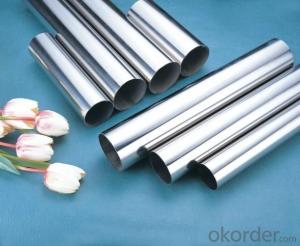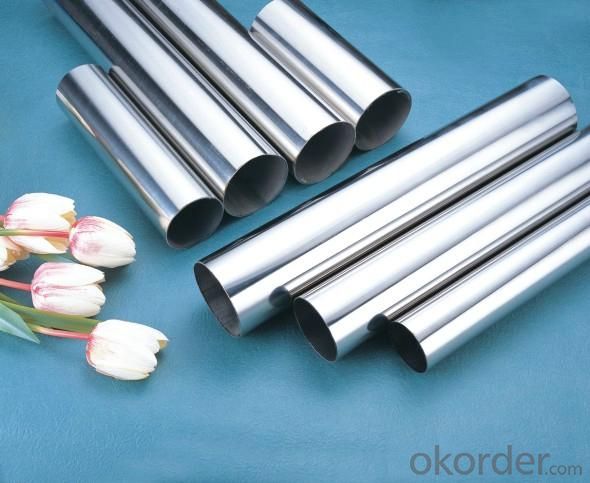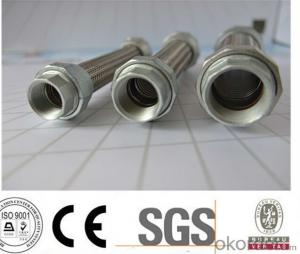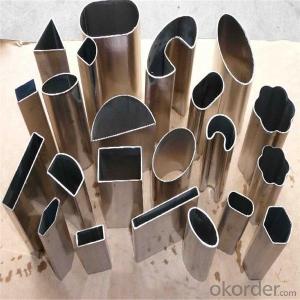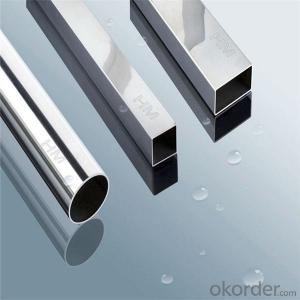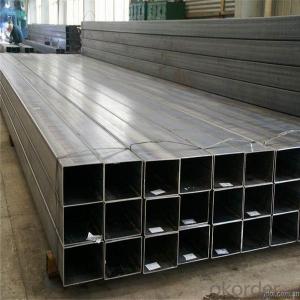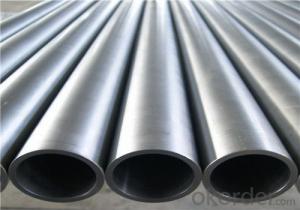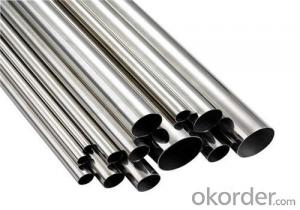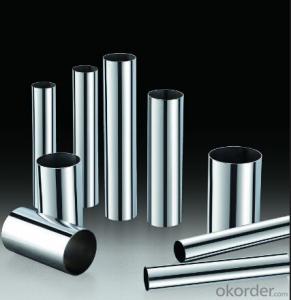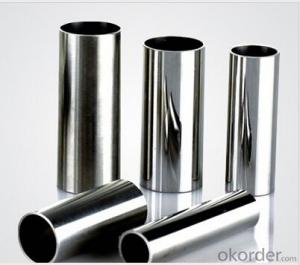stainless steel pipe/tube 304pipe,stainless steel weld pipe/tube,201pipe,stainless steel profile
- Loading Port:
- Tianjin
- Payment Terms:
- TT OR LC
- Min Order Qty:
- 25 m.t.
- Supply Capability:
- 1000 m.t./month
OKorder Service Pledge
OKorder Financial Service
You Might Also Like
Quick Details
| Place of Origin: | China (Mainland) |
Packaging & Delivery
| Packaging Detail: | stainless steel pipe/tube ,304pipe,stainless steel weld pipe/tube, stainless steel welded pipe/tube ,201pipe,stainless steel profile |
| Delivery Detail: | 20days |
Specifications
stainless steel pipe/tube 304pipe,stainless steel weld pipe/tube,201pipe,stainless steel profile
Standard ASTM A554, A249, A26
Standard | ASTM A554, A249, A269 and A270, A312 | |||||
Material Grade | 201 ( Ni 0.8%), 202 (Ni 3.5%~4.5%), 301(Ni 5%) 304 (Ni 8%, Cr 18%), 316 (Ni 10%, Cr 18%), 316L (Ni10%~14%), 430 | |||||
Outer Diameter | 6mm--159mm | |||||
Thickness | 0.3mm - 3.0mm | |||||
Length | 6m or as customers' request | |||||
Tolerance | a) Outer Diameter: +/- 0.2mm | |||||
b) Thickness: +/- 0.02mm | ||||||
c) Length: +/- 5mm | ||||||
Surface | 180G, 320G, 400G Satin / Hairline 400G, 500G, 600G or 800G Mirror finish | |||||
Application | Decoration construction, upholstery, industry instrument | |||||
Test | Squash test, extended test, water pressure test, crystal rot test, heat treatment, NDT | |||||
Chemical Composition of Material | Material
Composition | 201 | 202 | 304 | 316 | 430 |
C | ≤0.15 | ≤0.15 | ≤0.08 | ≤0.08 | ≤0.12 | |
Si | ≤1.00 | ≤1.00 | ≤1.00 | ≤1.00 | ≤1.00 | |
Mn | 5.5-7.5 | 7.5-10 | ≤2.00 | ≤2.00 | ≤1.00 | |
P | ≤0.06 | ≤0.06 | ≤0.045 | ≤0.045 | ≤0.040 | |
S | ≤0.03 | ≤0.03 | ≤0.030 | ≤0.030 | ≤0.030 | |
Cr | 16-18 | 17-19 | 18-20 | 16-18 | 16-18 | |
N | 3.5-5.5 | 4-6 | 8-10.5 | 10-14 | ||
Mo | 2.0-3.0 | |||||
Mechanical Property | Material Item | 201 | 202 | 304 | 316 | |
Tensile Strength | ≥535 | ≥520 | ≥520 | ≥520 | ||
Yield Strength | ≥245 | ≥205 | ≥205 | ≥205 | ||
Extension | ≥30% | ≥30% | ≥35% | ≥35% | ||
Hardness (HV) | <253 | <253 | <200 | <200 | ||
Payment | Payment by T/T, 30% as advance payment and 70% balance pay before shipping. |
Delivery time | A.7 days if this goods is stock goods. B.30 days if this goods will be produced after order |
Validity | Valid time is 3 days for price usually. |
stainless steel pipe/tube ,304pipe,stainless steel weld pipe/tube, stainless steel welded pipe/tube ,201pipe,stainless steel profile
- Q: Can stainless steel pipes be used for air conditioning systems?
- Indeed, air conditioning systems can utilize stainless steel pipes. Given its durability and resistance to corrosion, stainless steel proves to be a fitting material for a wide range of applications, including air conditioning systems. With their exceptional resistance to oxidation and rust, stainless steel pipes guarantee prolonged use and ward off any potential leakage. Moreover, these pipes possess the capacity to withstand elevated temperatures and pressure, rendering them perfect for integration within air conditioning systems.
- Q: Can stainless steel pipes be insulated with polyacrylonitrile?
- Yes, stainless steel pipes can be insulated with polyacrylonitrile (PAN). Polyacrylonitrile is a versatile and commonly used polymer that possesses excellent thermal insulation properties. It is often used as a foam or fiber insulation material due to its low thermal conductivity and high resistance to heat transfer. Polyacrylonitrile insulation can be easily applied to the surface of stainless steel pipes to reduce heat loss or gain, improve energy efficiency, and prevent condensation. It also provides protection against corrosion and mechanical damage.
- Q: What is the difference between 316 and 316H stainless steel pipes?
- The main difference between 316 and 316H stainless steel pipes lies in their carbon content. 316 stainless steel pipes have a maximum carbon content of 0.08%, which makes them suitable for applications where corrosion resistance is important, such as in marine environments. They are also known for their excellent welding and forming properties, making them a popular choice in various industries. On the other hand, 316H stainless steel pipes have a higher carbon content, typically around 0.04-0.10%. This increased carbon content provides improved high-temperature strength and creep resistance, making them suitable for applications where the pipes will be subjected to elevated temperatures, such as in high-pressure steam systems or in the petrochemical industry. In summary, while both 316 and 316H stainless steel pipes offer good corrosion resistance and overall performance, the 316H variant is specifically designed to withstand higher temperatures and offer better strength properties.
- Q: What is the difference between Schedule 30 and Schedule 40 stainless steel pipes?
- Schedule 30 and Schedule 40 are two different classifications of stainless steel pipes based on their wall thickness and pressure ratings. The main difference between Schedule 30 and Schedule 40 stainless steel pipes lies in their wall thickness. Schedule 30 stainless steel pipes have a thinner wall compared to Schedule 40 pipes. The wall thickness of Schedule 30 pipes is generally less than that of Schedule 40 pipes. This means that Schedule 30 pipes have a larger internal diameter compared to Schedule 40 pipes for the same nominal size. The thickness of the pipe walls directly affects the pressure rating and strength of the pipe. Schedule 40 stainless steel pipes are designed to handle higher pressure and have higher structural integrity due to their thicker walls. They are commonly used in applications where high-pressure fluids or gases are being transported, such as in industrial settings or for plumbing systems in commercial buildings. On the other hand, Schedule 30 stainless steel pipes are typically used in applications where the pressure requirements are lower. They are suitable for applications with more moderate pressure demands or where the fluid being transported does not require a higher pressure rating. In summary, the main difference between Schedule 30 and Schedule 40 stainless steel pipes is their wall thickness, with Schedule 40 pipes having thicker walls and higher pressure ratings compared to Schedule 30 pipes. The choice between the two depends on the specific requirements of the application, including the pressure and fluid being transported.
- Q: What is the difference between seamless and high-frequency welded stainless steel pipes?
- Seamless and high-frequency welded stainless steel pipes are two different types of pipes used in various applications. Seamless stainless steel pipes are manufactured through a process called seamless pipe manufacturing, where a solid billet is heated and pierced to form a hollow tube. This process ensures that there are no seams or joints in the pipe, making it ideal for applications that require high pressure, high temperature, or corrosive environments. Seamless pipes offer superior strength and reliability due to their uniform composition and absence of welding. On the other hand, high-frequency welded stainless steel pipes are manufactured using a different process known as high-frequency welding. This process involves passing a flat strip of stainless steel through a series of rollers to form a tube shape. The edges of the strip are then heated using high-frequency electrical currents and fused together to create a solid pipe. The resulting pipe has a visible welded seam along its length. While both seamless and high-frequency welded stainless steel pipes are made from stainless steel, there are some differences between them. One major difference is the manufacturing process. Seamless pipes are made without any welding, resulting in a pipe with no seams or joints. High-frequency welded pipes, on the other hand, have a visible welded seam along their length. Another difference is in their strength and reliability. Seamless pipes have a more uniform composition and absence of welding, which gives them higher strength and reliability compared to high-frequency welded pipes. This makes seamless pipes more suitable for applications that require high pressure, high temperature, or corrosive environments. Additionally, the production cost of seamless pipes is generally higher than that of high-frequency welded pipes. The seamless pipe manufacturing process requires more complex machinery and additional steps, leading to higher production costs. High-frequency welded pipes, on the other hand, involve a simpler and more cost-effective manufacturing process. In summary, the main difference between seamless and high-frequency welded stainless steel pipes lies in their manufacturing process, strength, and cost. Seamless pipes are made without any welding, offering higher strength and reliability, but at a higher cost. High-frequency welded pipes have a visible welded seam but are more cost-effective. The choice between the two types of pipes depends on the specific requirements of the application and the budget available.
- Q: What are the specifications of stainless steel decorative pipes?
- Decorative tubes, then more specifications. Our factory has the smallest 9.5MM, the largest to see how big you can, directly with the industrial pipe to polish it
- Q: Stainless steel pipes can not be less than the amount of chromium
- The chromium content of stainless steel is generally not less than said first why stainless steel tube is not easy to rust 12%-304 stainless steel tube, then why stainless steel will rust stainless steel is not easy to have a great relationship with the composition of stainless steel rust. In addition to iron, stainless steel contains chromium, nickel, aluminum, silicon and so on.
- Q: Are stainless steel pipes suitable for vacuum systems?
- Yes, stainless steel pipes are suitable for vacuum systems. Stainless steel is known for its high strength, durability, and resistance to corrosion, making it an excellent choice for vacuum applications. It offers a high level of leak-tightness, ensuring that the vacuum system can maintain the desired level of vacuum without any loss. Stainless steel pipes also have low outgassing rates, which is crucial in maintaining a clean and contaminant-free vacuum environment. Additionally, stainless steel is compatible with a wide range of gases and fluids commonly used in vacuum systems, making it a versatile material for various applications. Overall, stainless steel pipes are a reliable and effective option for vacuum systems due to their excellent mechanical properties and resistance to both internal and external factors that can affect the performance of the vacuum.
- Q: How do you calculate the wall thickness of a stainless steel pipe?
- The wall thickness of a stainless steel pipe can be calculated by subtracting the inner diameter from the outer diameter, and then dividing the result by 2.
- Q: Can stainless steel pipes be insulated with ceramic?
- Ceramic can indeed be used to insulate stainless steel pipes. It is commonly utilized in industrial settings that involve high temperatures. Ceramic insulation offers exceptional heat resistance and thermal insulation properties, making it an excellent choice. It can withstand extreme temperatures and effectively reduces heat transfer. Various industries utilize ceramic insulation to insulate pipes, tanks, furnaces, and other equipment. When applied to stainless steel pipes, ceramic insulation helps maintain the fluid's temperature, preventing heat loss or gain. Additionally, it provides protection against corrosion and mechanical damage. In summary, ceramic insulation is a suitable option for insulating stainless steel pipes in a wide range of applications.
Send your message to us
stainless steel pipe/tube 304pipe,stainless steel weld pipe/tube,201pipe,stainless steel profile
- Loading Port:
- Tianjin
- Payment Terms:
- TT OR LC
- Min Order Qty:
- 25 m.t.
- Supply Capability:
- 1000 m.t./month
OKorder Service Pledge
OKorder Financial Service
Similar products
Hot products
Hot Searches
Related keywords
